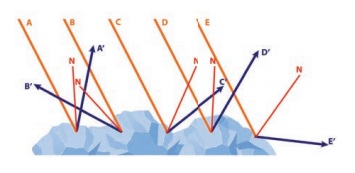Light | Term 3 Unit 1 | 7th Science - Types of reflection | 7th Science : Term 3 Unit 1 : Light
Chapter: 7th Science : Term 3 Unit 1 : Light
Types of reflection
Types of reflection
On a mirror we can see our image,
but not on the wall. Why? Both the surface reflects light. Only because the
reflected light comes to our eyes, we are able to see it. If the wall was not
reflecting light, then we cannot see it.

We saw earlier that the light
reflects off surfaces in a very predictable manner, in accordance with the law
of reflection. The laws of reflection holds good for all surfaces irrespective
of the shape. Vertical surfaces, angled surfaces, and even over the curved
surfaces, the laws of reflection holds good. As long as we can draw the normal,
perpendicular to the surface at the point can be drawn, the angle of incidence
at that point will be equal to angle of reflection.

The law of reflection is always
observed regardless of the orientation of the surface. If the surface is
smooth, and flat, all points on it have the normal in the same direction.
Therefore a set of parallel rays striking the surface will be reflected at an
angle, but the rays themselves will still remain parallel to each other.
However ,consider a surface which is
not smooth. Such as the surface of a wall. What happen when the light ray hits
the rough surface? Roughness of the wall means that each individual ray meets a
surface which has a different orientation. The diagram below depicts the case.
Five incident rays labelled as A, B, C, D and E approach a surface. The normal
line at each point of incidence is shown in black and labelled with an N. In
each case, the law of reflection is followed, resulting in five reflected rays
labelled A', B', C', D', and E'. While the incident rays were parallel to each
other, the reflected rays are going in different directions. The result is that
the rays of light are incident upon the surface in a concentrated bundle and
are diffused upon reflection.

Broadly, we can say that there are
two types of reflection. If the surface is smooth then we have specular
reflection. The parallel light rays striking the surface gets reflected, yet
individual reflected rays remain parallel.
If the surface is rough, then we
have diffused reflection. Light rays, after reflection go in many directions.
In fact during the day, our class
room is illuminated by sunlight . Walls and floors are exposed to diffused
reflection. Suppose walls were smooth mirror like.

Then sunlight entering through the
window will get bounced by the floor at an angle above towards the roof. And it
will never get reflected to left or right. That is left and right walls will
remain dark. However walls and floors are not smooth surfaces. Therefore,
incident light from the window get bounced in all directions that the whole
room is illuminated with diffused light.
Related Topics